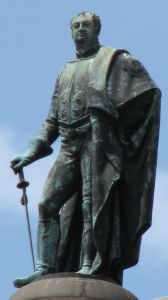 The Duke of York, Waterloo Place.
The Duke of York, Waterloo Place.
Waterloo Place, at the end of Lower Regent Street, five minutes walk from Trafalgar Square/Charing Cross and the National Gallery along Pall Mall, or five minutes down Lower Regent Street from Piccadilly Circus and the Statue of Eros.
 The Duke of York, Waterloo Place.
The Duke of York, Waterloo Place.
Here there is a good crop of outdoor Victorian statues. The one on the top of the tall Tuscan pillar - instinctively one wants Nelsonís Column to be the only such thing in London - is the Duke of York, by Richard Westmacott. It was erected by public subscription at a cost of 26,000 pounds. The plain column of Aberdeen granite is 120 ft high, was designed by B. Wyatt and put up in the 1830s. The height of the pillar came in for much disparaging comment, and was the subject of a poem in the New Monthly Magazine which included the lines: "Thou pillar, longitudinally great, // And also perpendicularly straight". Our picture is taken at some distance with a zoom lens.
Bell's Crimea memorial. 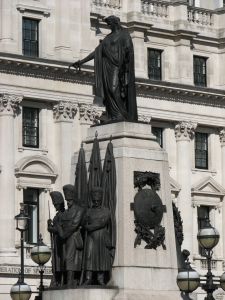
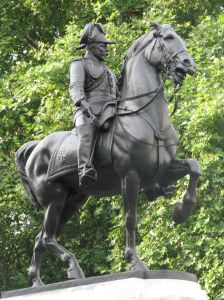 Mackennal's Edward VII.
Mackennal's Edward VII.
The column is at the head of a grand stair leading down to The Mall and St James' Park. By the column, facing back up Regent Street, there is a sign indicating the various monuments. Looking in that direction, in the centre is an equestrian statue of Edward VII by the Australian-born Bertram Mackennal, sculpted in 1924 - several views of this statue are near the end of the horse statues for drawing page. Behind, the Memorial to the Crimea (also called the Guard's Memorial) of 1854/9 by John Bell. The granite pedestal has three bronze figures of a Grenadier, a Fuselier and a Coldstream Guard. A smaller block of granite has to the back a pile of cannon - the actual broken Russian guns from Sevastopol. At the top is a bronze allegorical figure of Honour, with arms extended. A sculpture of Lord Herbert of Lea by J. H. Foley is next to the Memorial, and also a Florence Nightingale (1867) by A. G. Walker.
Still looking up Regent Street, on the left hand side is a statue by J. E. Boehm of Field Marshall J. F. Burgoyne (1874) and one by M. Noble of John Franklin (1866), who died on an attempt to find the North West Passage.
On the right hand side is another J. E. Boehm sculpture, this time of Lord Lawrence (1882), with sympathetic weathered face. Next is a statue by Carlo Marochetti of Lord Clyde (1867), the most interesting statue of the lot, by virtue of a classical group of Britannia seated on a lion in front of the main pedestal. Further up is a statue of Scott of the Antarctic (1915) by Lady Scott.
Waterloo Place, like Regent Street, was designed by John Nash (though all the main part of Regent Street has been replaced - see this page). As noted in an account written some little time after his death:
"Whether the stranger traverses the splendid line of Regent Street, the Quadrant and Portland Place until he reaches the Regent's Park, or takes his way from Waterloo Place towards Somerset House, his first enquiry would be - to whose taste, genius and enterprise are these improvements owing? Mr Nash, to whom abuse and ridicule was the fashion of the time in which he lived."
Of the buildings, on the left is the elegant Athenaeum (1827-30 by Decimus Burton) with a fine frieze and golden statue - a Pallas Athenae by E. H. Baily. The frieze is by John Henning Sr, and apparently the interior was decorated by Alma Tadema. On the right the former United Services Club, originally by John Nash (1827), but then remodelled by Decimus Burton in 1858.
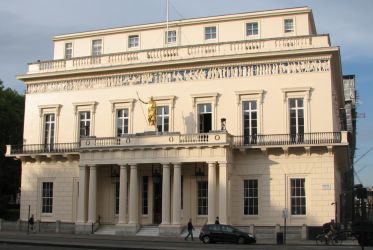
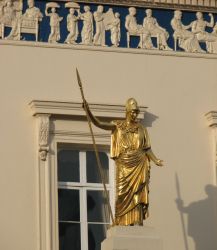 The Athenaeum, and close up of the Athena and the frieze.
The Athenaeum, and close up of the Athena and the frieze.
Incidentally, the road crossing Waterloo Place is Charles Street, where the sculptor Chantrey lived as a young man, and it was here that he exhibited some of his earliest busts.
Walking through towards Trafalgar Square, at the junction of Cockspur Street with Pall Mall East, on an island surrounded by busy traffic, is an equestrian statue of George III. It is by Matthew Cotes Wyatt, dates from 1835/6, and cost some £4,000, including the 12ft high granite pedestal. It is noted on the Cockspur Street page.
London sculpture // Sculpture pages
Sculpture walk along Piccadilly // Eastward to Cockspur Street // Southerly, along the Mall
Visits to this page from 13 Mar 2014: 11,013